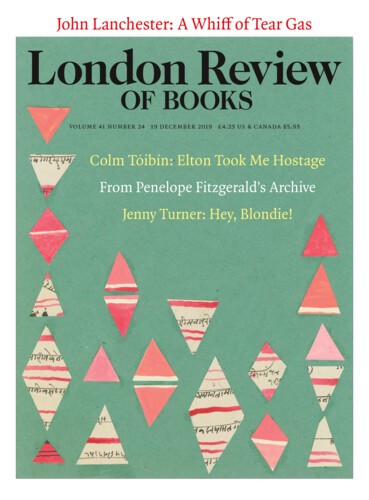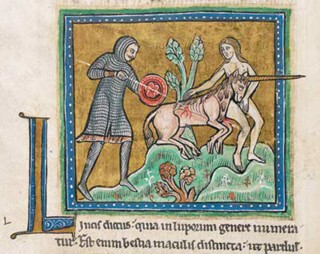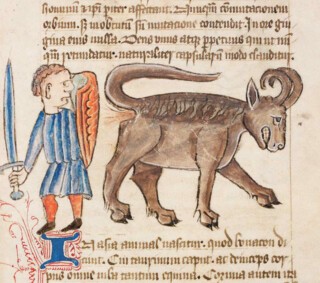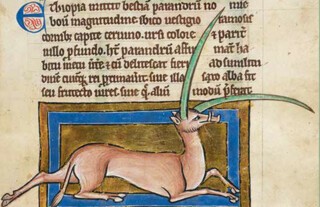Medieval people lived in much closer proximity to animals than most of us do today, but had less sense of their variety. Who in 12th-century England would have seen an elephant or a crocodile? Tales filtered back from Crusaders and distant travellers of a giant herbivore with a nose so long and pliable that it could pick up men and seat them on its back, and of an armour-plated carnivore that lurked in water and could be mistaken by the unwary for a log of wood. These were as improbable – and therefore as possible – as a white horse with a long horn in the middle of its forehead (not least because such horns were sometimes found, and might even be transformed into bishops’ staffs).
Medieval bestiaries are evidence of a long chain of textual and visual transmission. Were unicorns the result of some long-ago account of a rhinoceros – an animal that did appear on occasion in Roman arenas? It’s impossible to say, and the many contributors to Book of Beasts (produced in conjunction with an exhibition at the Getty Centre in Los Angeles earlier this year) waste little or no time trying to trace ultimate origins. The material they have is hard enough to disentangle: the book lists 34 bestiaries, which include more than a third of all surviving illuminated examples, while the number of unilluminated bestiary manuscripts is beyond count.
One source for medieval bestiaries was the second-century Alexandrian Greek Physiologus, a kind of ‘Book of Nature’ that had entries on stones and plants as well as animals, fish and insects. This was rapidly translated, with additions, into Latin and Old English verse, giving us accounts of the panther, the partridge, the whale and, at considerable length, the phoenix. The Latin version may well have been a set text for medieval schoolboys, and possibly also constituted a permissible entertainment for monastic refectories. Isidore of Seville’s Etymologiae (c.610) expanded on the Physiologus by relating the Latin names of animals to any word that sounded alike. Thus apes are called simia ‘because one observes in them considerable similarity to human reason’ (my italics), while the tiger is so called for its swiftness – the Median and Persian word for ‘arrow’ was (allegedly) tigris. The great popularity of bestiaries was due in part to the novelty of strange places and creatures – the griffin and the siren and the onocentaur – but also, and overpoweringly, to the opportunity these accounts provided for the transmission through allegory of the dominant cultural narrative of sin and salvation.
The first section of Book of Beasts presents 15 full-page reproductions of animal images from different bestiaries, each with allegorical commentary from an English ‘second-family’ bestiary (a work based on the Etymologiae). The beaver, for example – illustrated by a rather sad image from Harley MS 4751 (c.1300) – is ‘a very gentle animal … whose testicles are extremely useful for medicine. Physiologus says that when the beaver knows the hunter is following him, he cuts off his testicles with his teeth, and throws them before the hunter, and thus escapes.’ If the hunter continues to pursue him, he cocks one of his hind legs and displays his missing testicles, as in the Harley image.
What does this mean? The answer is precise: ‘Any man who is turned towards God’s command, and wishes to live chaste, cuts himself off from all vices and all acts of lewdness, and tosses them into the Devil’s face.’ To force the point home an Isidorian etymology is given: ‘The beaver [castor] is named from castrating [castrando].’ Similarly we learn that when a female ape bears twins ‘she prefers one and rejects the other.’ If hunted, she carries her favourite and slings the other on her back; but under duress ‘she drops the baby she prefers and involuntarily carries the one she scorns.’ This tells us that the sinner trying to repent is all too likely to forsake the good, and be unable to shake off the bad. And so on.
Some creatures seem to have defeated the allegorists. The bonnacon, we’re told, has the head and body of a bull, the mane of a horse and horns that turn inward. Its tactic of hunter-evasion (a preoccupation of bestiarists) is to emit a terrible fart, ‘three acres long [and] so hot that it scorches whatever it touches’. There is a fine manuscript picture in the Royal Danish Library of a disgusted looking hunter, holding up a shield in front of his face. One can’t help wondering where the notion of the bonnacon came from. Surely no one in medieval Europe could have encountered a skunk? And there are no clues to its meaning: as far as we can tell, the bonnacon escaped allegory (suggestions would be welcome).
The most striking feature of Book of Beasts is its 270 colour plates. The front plate shows a griffin, half-lion, half-eagle, with a man dangling from its beak: presumably one of the ‘Arimaspians’ who, according to Milton (borrowing both from Herodotus and from Pliny’s Natural History), robbed the griffins’ hoards of gold. Shortly after there is a full-page plate of a mild-looking elephant, with a green and white striped trunk and a tower on its back from which soldiers with crossbows, pikes and mattocks beat off axe-wielding assailants. Further on, lions bring their dead cubs back to life by breathing on them – a gift for the allegorist – and a tiger cub is stolen from its mother, who is deceived by a mirror into guarding the cub’s reflection. Unicorns are repeatedly shown with their heads in a maiden’s lap (sometimes a naked maiden: a gift for the illustrator, or perhaps for the aristocratic patron). It’s clear from the evidence provided here that between the tenth and fifteenth centuries, hundreds, if not thousands, of European artists poured their skill and imagination into creating bestiaries, perhaps the more readily because they lacked knowledge of what a tiger, elephant, griffin, basilisk or manticore actually looked like.
Sometimes ordinary life intrudes. A text from Bodley 764 (c.1225-50) neatly describes the cat: ‘This creature is called mouser because he kills mice. The common word is cat because he captures [captat] them … Catus is the Greek word for cunning.’ The mice the cat catches are ‘greedy men who seek earthly goods’, but, as Susan Crane comments, the accompanying pictures show an artist ‘speculat[ing] imaginatively on the hidden life of cats at night’. There are three cats: one curled up in front of a fire (apparently cleaning his behind), another with a mouse in his paws, and a third on his hind legs, trying to reach into a birdcage – almost a Breughel before its time.
Quite often the beasts in the pictures try to climb out. As Elizabeth Morrison points out in her essay, it was difficult to get everything in, and artists had to collaborate with their scribes. A manuscript from St Petersburg contains a picture of a yale, a creature described by Pliny as a kind of antelope ‘the size of a hippopotamus, with an elephant’s tail … the jaws of a boar, and moveable horns more than a cubit in length … presented to the attack or sloped backward in turn as policy directs’. In the image the yale’s enormous horns erupt beyond its frame, slicing through the text and almost touching the parandrus (a kind of chameleon-stag) illustrated above it – ‘a clever commentary on the fact that its horns can move in any direction’. This is an example of good design, but linking text and picture often proved too complicated: in a manuscript from Paris ‘none of the images … matches the text they were supposed to introduce,’ and the hedgehog and fox that should be included don’t appear at all.
Pictures were sometimes used to make a social point. In Bodley 764, a carefully rendered goshawk sits on the arm of a lady, possibly the manuscript’s patroness, Cecily d’Aubigny, while in the background a peasant scares birds into flight. The text tells us that ‘hawks are usually carried on the left hand [which] represents temporal things, the right everything that is eternal.’ The lady is carrying her hawk on the right hand, however, and is, as Crane writes, ‘emphatically the dominant figure in the image, exceeding the full height of the frame … and gesturing in command to two beaters’. The birds about to take flight are not doves (as, allegorically, they ought to be) but quite clearly mallards, once again carefully rendered with curly tail feathers and white-ringed necks. This image is just as much a statement of rank and prestige as the horse and country estate pictures of the later English aristocracy.
Bestiaries have continued to have their fans. Unicorns are pervasive in modern fantasy and J.K. Rowling has made good use of ‘fantastic beasts’, basilisks, centaurs and hippogriffs. In T.H. White’s The Witch in the Wood, the second book in his Arthurian series, Sir Palomides and Sir Grummore read a book with ‘pictures on almost every page. They were pictures of griffins, bonnacons, cocodrills, manticores, chaladrii, cinomulgi, sirens, peridexions, dragons, aspidochelones, and many other flora and fauna common in those days.’ Some of these creatures are unknown even to Book of Beasts, though the cinnomolgus, or cinnamon bird, is featured.
As Morrison points out, even those of us ignorant of bestiaries use phrases that originate with them. ‘Crocodile tears’ comes from the cunning cocodrill; ‘licking something into shape’ derives from bear cubs, which according to bestiaries are born shapeless and literally licked into shape by their mothers. In the same way, the medieval world had a ‘bestiary beyond the book’, in Meredith Cohen’s phrase. Griffins appear on top of cathedrals, as in Pisa. They feature on gargoyles, on capitals, on bishops’ croziers, on church misericords and even on parade saddles. Christine Sciacca’s short piece on ‘feline aquamanilia’ gives several examples of bronze water jugs shaped as lions – or, sometimes, as cheetahs or leopards – showing the influence of Africa and reminding us that, as its name suggests, the leopard was thought to be the product of an adulterous relationship between a lion and a ‘pard’ or panther. Most of all, bestiary creatures were subjects for medieval tapestries: see the particularly fine pelican from Lüneburg feeding her young with her own blood, and the Flemish millefleurs tapestry, now in Minneapolis, with its significant placing of three rosebushes (the Trinity), and careful alignment of stag, unicorn and lion, panther, hound and lamb, all part of ‘a rich language of symbolism’ to be decoded and explicated.
Send Letters To:
The Editor
London Review of Books,
28 Little Russell Street
London, WC1A 2HN
letters@lrb.co.uk
Please include name, address, and a telephone number.




